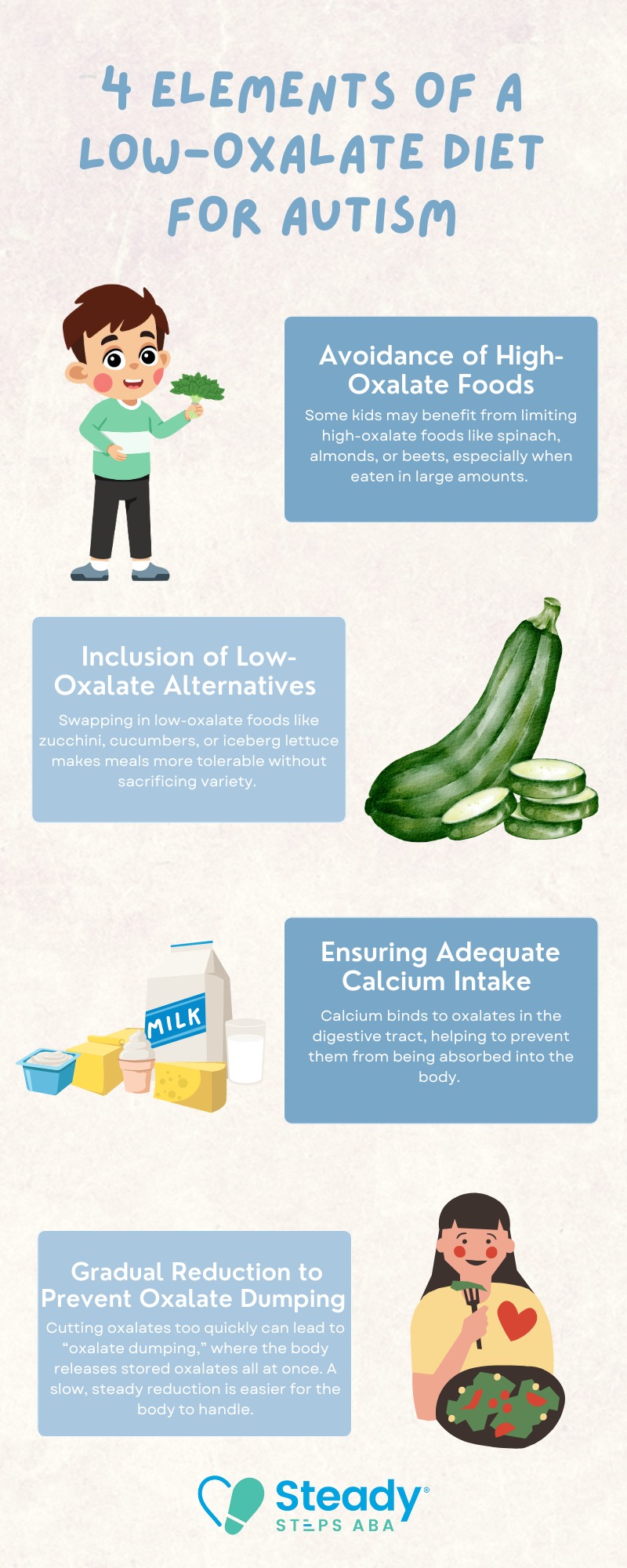Key Points:
- Emerging research suggests a potential connection between oxalates and autism, especially in terms of digestion, behavior, and inflammation.
- Oxalates are natural compounds found in certain foods that may affect individuals with autism differently due to metabolic or gut-related issues.
- A low-oxalate diet is sometimes explored by parents, but it should only be considered with clinical guidance and not as a substitute for behavioral therapy or medical care.
Autism is a complex condition, and many families explore a wide range of options to support their child’s health, including dietary changes. One dietary topic gaining attention is oxalates and autism, particularly in relation to gut health, inflammation, and behavior.
While there’s limited large-scale research directly linking oxalates to autism symptoms, some parents and clinicians have observed notable changes when reducing high-oxalate foods.
According to some studies, children with autism show 3-fold greater oxalate levels compared to their neurotypical peers. Understanding how oxalates work and whether they impact autistic individuals differently is key to making informed decisions. In this article, we’ll go over the link between oxalates and autism and how they can affect the body.
What is the Link Between Oxalates and Autism?
There is no confirmed direct cause-and-effect link between oxalates and autism, but some studies and anecdotal reports suggest that oxalates may influence behavior, digestion, and inflammation in certain individuals with autism. This is particularly relevant for individuals with gut issues, metabolic imbalances, or food sensitivities.
Oxalates are naturally occurring compounds found in many plant-based foods. While they are harmless in moderation for most people, high oxalate levels can cause problems in some, especially those with impaired detoxification pathways or gut dysbiosis, both of which are common concerns in autism research.
What are Oxalates and How Do They Affect the Body?
Oxalates, or oxalic acid, are found in many healthy foods such as spinach, almonds, beets, and sweet potatoes. The body also produces oxalates during metabolism. In healthy individuals, they are usually excreted through urine without issues. But for those with compromised digestion or specific metabolic challenges, oxalates may accumulate and cause problems.
High oxalate levels can:
- Bind with calcium and form kidney stones
- Irritate the gut lining
- Trigger inflammation
- Contribute to joint pain or fatigue
- Influence urinary or skin sensitivity
Because of their role in inflammation and gut permeability, some researchers are investigating how oxalates might interact with autism symptoms, especially in cases where gastrointestinal issues are present.

Why Might Autistic Individuals Be More Sensitive to Oxalates?
Several overlapping factors may make individuals on the autism spectrum more sensitive to oxalates. Many autistic people experience digestive difficulties, food sensitivities, or metabolic imbalances that could make oxalate accumulation more likely.
Potential reasons for oxalate sensitivity include:
1. Gut Dysbiosis
When the gut’s bacterial balance is off, it can affect digestion, mood, and even behavior. This imbalance may contribute to food sensitivities or discomfort that influences eating habits.
2. Leaky Gut Syndrome
Leaky gut happens when the intestinal lining becomes too porous, allowing unwanted particles to pass into the bloodstream. This can trigger immune responses and lead to inflammation or discomfort after eating.
3. Low Levels of Oxalate-Degrading Bacteria
Some kids have low levels of bacteria that help break down oxalates found in certain fruits, veggies, and nuts. Without these microbes, high-oxalate foods can lead to irritation or buildup in the body.
4. Impaired Sulfation or Detoxification Pathways
Difficulty processing certain compounds, like food additives or environmental chemicals, can make some foods harder to tolerate. Supporting detox pathways may help reduce overload and improve reactions.
5. Nutrient Deficiencies
Lacking key nutrients like magnesium, calcium, or vitamin B6 can impact mood, energy, and digestion. These deficiencies might also make sensory sensitivities or food avoidance more pronounced.
These issues can result in oxalates being absorbed in higher amounts than usual, rather than being passed through the digestive tract and eliminated.
11 Foods High in Oxalates
Oxalates are present in many otherwise healthy foods. While these are fine for most people, individuals with suspected oxalate sensitivity may need to reduce or rotate their intake with the guidance of a professional.
Common high-oxalate foods include:
- Spinach
- Beets
- Sweet potatoes
- Almonds
- Cashews
- Rhubarb
- Chocolate
- Buckwheat
- Soy products
- Berries
- Chia seeds and sesame seeds
Oxalate levels can vary based on preparation and portion size. Boiling, for instance, may reduce oxalate content in some vegetables, but this isn’t always enough to eliminate their impact for sensitive individuals.
What is a Low-Oxalate Diet?
A low-oxalate diet involves limiting or removing high-oxalate foods to reduce oxalate buildup in the body. It is sometimes used by individuals with kidney stones or unexplained pain, and increasingly by parents of children with autism who report positive behavioral or digestive changes.
Common elements of a low-oxalate diet:

It’s critical that any low-oxalate approach be done gradually and under supervision. Abrupt dietary changes can lead to symptoms like fatigue, mood swings, or rashes due to oxalate release.
Exploring the Connection Between Oxalates and Behavior
Some parents report behavioral improvements in their autistic children after reducing dietary oxalates. These may include:
1. Less Irritability
Lowering oxalates may ease mood swings or frequent irritability. A more balanced mood can make daily routines and interactions feel smoother.
2. Fewer Sensory Meltdowns
Reducing oxalates might decrease the frequency or intensity of sensory overload moments. Kids may feel less overwhelmed by sounds, textures, or lights.
3. Improved Focus
Some children show better attention and task engagement when dietary oxalates are lowered. This can support learning, play, and overall participation in daily activities.
4. Better Sleep
Parents sometimes report more restful sleep and fewer nighttime disruptions after reducing oxalates. Improved sleep can lead to better energy and mood during the day.
However, these reports are anecdotal and not yet backed by controlled clinical studies. It’s also possible that these changes are due to other factors, such as improved gut health, fewer food reactions, or structured dietary routines. For a deeper look at how certain substances may uniquely affect individuals on the spectrum, explore our article on How Caffeine Sensitivity Impacts People with Autism.
That said, because oxalates may influence inflammation and neurological pathways, the link between oxalates and autism remains a valid area for further investigation.
Why Some Families Explore Low-Oxalate Diets for Autism
Making dietary changes for someone with autism can be a big step, and should always be approached with caution. A low-oxalate diet may be worth exploring if your child has:
1. Chronic Gut Issues
Ongoing digestive problems like bloating, constipation, or stomach pain may be linked to high oxalate levels. These symptoms can persist even with an otherwise healthy-looking diet.
2. Unexplained Rashes or Joint Pain
Some people experience skin rashes or joint discomfort without a clear cause, which may be tied to oxalate buildup. These physical symptoms can sometimes be overlooked as food-related.
3. Kidney Stones or Calcium-Oxalate Crystals
Kidney stones—especially those made of calcium oxalate—can be a clear sign of excess oxalates in the body. Managing oxalate intake may help prevent future stone formation.
4. Negative Reactions to High-Oxalate Foods
Reactions like irritability, fatigue, or discomfort after eating certain foods could be a sign of oxalate sensitivity. Spinach, almonds, and sweet potatoes are common culprits.
Before starting, it’s essential to consult with a registered dietitian or functional medicine practitioner. Removing high-oxalate foods without nutritional guidance could lead to deficiencies or food refusal, especially for picky eaters on the spectrum.
5 Strategies That Support Gut and Behavioral Health in Autism
Oxalates are just one piece of the puzzle. A holistic approach to managing autism symptoms often involves attention to diet, behavior, and the environment. Considering all these factors together can lead to more sustainable and personalized outcomes over time.
Other strategies to consider include:
1. Probiotic Support to Restore Gut Balance
Probiotics can help replenish beneficial bacteria in the gut, which may be disrupted in individuals sensitive to oxalates. A healthier gut can improve digestion, mood, and food tolerance over time.
2. Anti-Inflammatory Diets
Some kids benefit from reducing inflammatory foods like gluten or dairy, especially if they have sensitivities. These changes can support overall gut health and reduce discomfort during meals.
3. Supplementation
Nutrient supplements can help fill in gaps caused by restricted diets or absorption issues. It’s important to work with a provider to choose the right types and doses for each child’s needs.
4. Behavioral Therapy
ABA and other behavioral approaches can help create structured, positive mealtime routines. These strategies also support gradual change and reduce fear or anxiety around trying new foods.
5. Gradual Exposure to New Foods
Introducing new foods slowly—starting with sight, smell, then touch and taste—can ease the pressure around eating. This gentle method allows kids to build comfort and curiosity at their own pace.
Families often see the best results when multiple systems—nutritional, behavioral, and emotional—are supported in tandem.
Maximize Your Child’s Success with ABA Therapy
Understanding the potential impact of oxalates and other dietary factors is important, but it’s just one part of a broader care plan. At Steady Steps ABA, we provide ABA therapy in Maryland that supports families through structured, individualized behavior interventions.
Whether your child is working on food tolerance, emotional regulation, or daily routines, our therapists help break down goals into achievable steps.
Contact us today to learn more about ABA therapy in Maryland and how we can support your child’s development alongside any dietary or sensory strategies you’re exploring.






